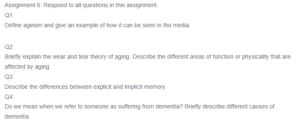Ageism
Defining Ageism and Examples of How It Is Seen in the Media
Ageism can be described as how humans think, feel, and act around people or themselves based on their age, according to the Global Report on Ageism by the World Health Organization (Friedman, 2021). Ageism is generally everywhere in today’s world, including media, the workplace, healthcare, school, and other fields. Ageism can sometimes be intentional or unintentional and can lead to negative impacts such as affecting the people being thought of or discriminated against by affecting them mentally and physically. Ageism appears in several forms, such as personal ageism, which is personally deciding to be disrespectful to a certain age group. Other forms include self-directed ageism and institutional ageism. Do you need any assignment help? our work is highly efficient and guaranteed.
Ageism in the media is very alarming and has been ignored or rather taken casually. The media is well known to put an end to social problems and create awareness in areas such as racism, sexuality, and more, but when it comes to ageist comments, it has been an ignored field. Ageism in media is visible in various ways. For example, magazines, clothing brands, makeup companies, and skincare brands only use young people for advertising, and older people are rarely seen in them. This is because of the stereotypical opinion that things like makeup are only used by young people, even though this is not exactly the case. On the other hand, advertisements for medical insurance and medication are mostly associated with older people.
The Wear and Tear Theory of Aging and the Areas of Function or Physicality Affected By Aging
Dr. August Wisemann, a German Biologist, proposed the wear and tear theory of aging as how he understood the aging of humans in 1882 (Sattaur et al., 2020). The theory was based on how inanimate objects such as phones and other machinery wear out and become of no use. Dr. August related this explanation to how the continuous decline of the body’s cells and tissues due to wear and tear causes human aging. However, no matter how well humans try to live, they die at some point (Sigelman & Rider, 2009).
Aging has physical and mental effects that can be complicated with time. For instance, the most cognitive change associated with aging is memory, which is categorized into episodic memory, semantic memory, procedural memory, and working memory (Peter, 2006). Other areas of physicality affected by aging include muscles, joints, and bones, whereby the bones shrink in size and become weaker, and muscles also become weaker.
A Description of the Differences between Explicit and Implicit Memory
Implicit and explicit memory are types of long-term memory; implicit memory is remembering information effortlessly and unconsciously, while explicit memory involves consciously working to remember information. Explicit memories can be verbally explained, while implicit memories are non-verbally explained. For instance, singing lyrics to a song can be easily done unconsciously compared to trying to remember a mathematical equation from school. Implicit memories also become obvious with repetition, while explicit memories are encrypted and retrieved later.
The Meaning of Dementia and Different Causes of Dementia
Dementia generally means loss of memory or language or making decisions that interfere with everyday activities and is not a specific type of disease. Dementia is majorly common among older adults, with statistics showing that among people aged 65 years, there are at least five million adults with dementia as of 2014. By 2060, this statistic might rise to almost 14 million.
The most common cause of dementia is Alzheimer’s disease, which destroys memory and mental functions. Other causes include diabetes, smoking, and depression. Despite dementia being common among the elderly, it does not mean that aging is a cause of it. In conclusion, ageism is an ongoing problem worldwide that needs attention to avoid negative results on human beings and enhance growth as well.
References
Friedman, H. (2021). Institute for Public Health. Retrieved November 27, 2022, from https://publichealth.wustl.edu/.
Peter, R. (2006). National Center for Biotechnology Information. Retrieved November 28, 2022, from https://www.ncbi.nlm.nih.gov/.
Sattaur, Z., Lashley, L., & Golden, C. (2020). NSUWorks – Nova Southeastern University Institutional Repository. Site. Retrieved November 28, 2022, from https://nsuworks.nova.edu/.
Sigelman, C. K., & Rider, E. A. (2009). Life-span Human Development. Wadsworth Cengage Learning.
ORDER A PLAGIARISM-FREE PAPER HERE
We’ll write everything from scratch
Question

Ageism
Assignment 6: Respond to all questions in this assignment.
Q1:
Define ageism and give an example of how it can be seen in the media.
Q2:
Briefly explain the wear and tear theory of aging. Describe the different areas of function or physicality that are affected by aging.
Q3:
Describe the differences between explicit and implicit memory.
Q4:
Do we mean when we refer to someone as suffering from dementia? Briefly describe different causes of dementia.

